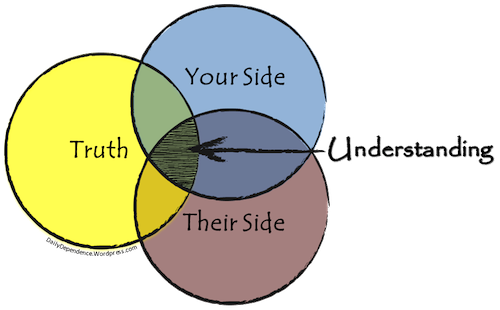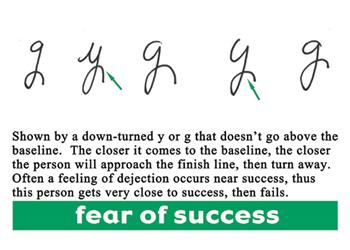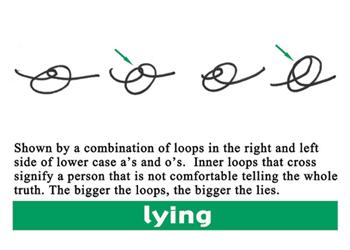Everyone who engages in handwriting analysis will encounter the challenge of how to share a very negative personality trait with a person.
If you are direct, you can trigger defensiveness and confrontation which is not helpful for you or the person whose handwriting you are analyzing.

A great thing about handwriting analysis is that almost every negative trait can be reframed as something positive.
Normally, something positive goes back to how a person deals with safety, security, or survival.
Remember this: People want to survive.
As they are growing up, people ask themselves (either consciously or subconsciously), “How do I survive?” and “How do I survive better?”
Through the survival strategies they create, they develop traits that can be positive and can be negative.
Almost every negative trait (even for the most psychotic people at some level) arises from thinking, “If I adopt this personality trait, if I adopt this behavior, my propensity to survive will increase.”
Think about all the popular TV shows like Criminal Minds and CSI with the darkest profiles of people and criminals on them. You may wonder, “How in the world does kidnapping or doing the things that they do help them survive?” In their very warped minds, they feel their actions are paths to get them some sort of emotional fulfillment and, indeed, survival is one of those.
In this article, I am not going to show you how to identify these traits in the handwriting. I’m operating with the supposition that you already have some basic knowledge of handwriting analysis and the methodology I teach.
Here I’m simply focusing on how to share difficult information in a way that will not trigger defensiveness but will instead engage the person so that they will be open to hearing the information you are sharing.
Basically, you want to share the information in a way that you can get agreement so that you can really help the person.
The Challenge
One challenge you may face when you first start analyzing handwriting is that you see really negative things in the writing and might not want to say it. Perhaps you do not want to hurt anyone’s feelings, especially if you are in a social situation.

Your instinct is right. There is absolutely no benefit to offending anyone. It does not help at all.
The Reframe
What you need to do is reframe the “negative” into something that is palatable, that can be received without triggering the person.
To be at ease with this technique is not about memorizing a word or phrase. It is about the ability to fully understand the source of the personality trait, the person’s history, the person’s fear, the person’s aberration.
If you understand those things, then you can articulate what you need to communicate in a thoughtful way that says, “I understand you. I’m not judging you. This is how it may play out in your life.”
One key approach is to phrase a difficult statement in a question, a question that you suspect they can answer “yes” to – that is where you get their agreement, their buy-in to what you are presenting.
Two such questions to keep ready are: “Do you recognize this?” and “Does this ever happen?”
To help you understand this approach in real situations, I am going to use three traits you probably will encounter a lot: Fear of Success, Domineering, and Lying.
------------ Special Newsletter Reader Offer ------------

Visit the discount page now.
Fear of Success

The first step is to really understand what the trait is and what it means in a person’s life.
If you tell a person that they have Fear of Success, you will probably get some opposition. They will probably flat out disagree.
In our culture, we are taught that success is important. It is something most everyone consciously strives for; so, if you tell someone straight out that they have Fear of Success, you are suggesting something that they consciously feel they are doing the opposite.
They probably believe they are eager for success.
So, think about what the trait actually means.
With Fear of Success, you find that they fail to cross the finish line.
Perhaps as they near a goal a crisis happens.
With that in mind you could present Fear of Success in this way:
“You know, it seems like when you get close to achieving a particularly important goal, a crisis happens or disaster happens, and for some reason you do not reach that goal. Have you noticed as you get close to certain targets, you come up short?”
In my experience, when I phrase Fear of Success in those terms, people will usually recognize what I am talking about and agree.
They’ll ask, “Why do I do that?” and “Why do I self-sabotage?” and “Why do these things happen to me?”
Then, you have your opening. Then, you can explain the dynamics of how most people are attracted toward pleasure and some are motivated away from pain.
The Fear of Success has sort of a dual connection.
Either the idea of success is painful for a person and they avoid it, or the idea of failure has pleasure associated with it.
Success can become associated with pain in many ways. Perhaps they succeeded in something important by beating a friend and lost that friendship.
It may be harder to think of an example of how failure can have pleasure associated with it. One possibility could be a child getting an ice cream cone for coming in third place.
If your family rewarded you for failing as a child, then you may have gotten more love and affection for failing than you did for succeeding. That could be some of the dynamic as to what created that connection between failure and a better way to survive (one with more love in it).
Domineering

 When you find indicators of a person being Domineering, you may wonder, “How in the world can I tell someone he’s an obnoxious, pushy jerk without actually offending him?”
When you find indicators of a person being Domineering, you may wonder, “How in the world can I tell someone he’s an obnoxious, pushy jerk without actually offending him?”
It seems impossible.
But, go back to what Domineering actually is and when and how it might be useful for survival or better survival. A person with a useful character trait is going to feel good about having it.
A person who is Domineering is dominant and wants to be in charge. Where might that be useful? If you are a CEO, you might want to be the dominant, in-charge person. You could see it as a positive, useful characteristic in that context.
Most people who are Domineering actually think of themselves as leaders.
And, most people who are Domineering have a belief that they are the most competent person in the room and that other people are idiots.
So, let’s soften that information by asking a question.
You can soften it further by asking permission to ask a question. It looks like this: “I see that your handwriting shows Domineering. This usually means that you need to have control; so, I’m just wondering… can I ask you a question?”
“I’m just wondering… can I ask you a question?” is a fantastic softener or introduction. You get their agreement here in this question. (They have to say “yes” for you to proceed and reveal more information about them.)
Then, you can continue to get to the real core of what is going on.
You could also ask “Would you mind if I ask you a question?”
Then, you can continue, “What happened in your past that made you feel that being in charge was really the safest place for you to be? Are you a born leader, or did something specific happen?”
See how they would see that question as containing a compliment?
If you can get agreement and compliment them on who they are, you are likely to really open them up to what comes next.
Intentional Deceit

You can also refer to this trait simply as “lying.”

This is another one of those “uh oh” moments in handwriting analysis where beginners often despair at how to share that information.
You don’t want to use a euphemism like, “You sometimes stretch the truth” because that could still feel insulting.
So, I usually combine directness with a possible rationale like this: “I don’t know how to say this diplomatically…. You have a fear of being totally honest with people. Because of this fear of retribution, you are going to tell little white lies once in a while.”
By saying, “You have a fear that other people should not be told the truth because they’re going to react poorly” you are giving an underlying rationale.
You suggest an underlying fear that may be the reason for their Intentional Deceit.
When I approach lying in this way, I invariably get “Oh my God! You are so right!”
People admit it. They know they make things up.
But, if you had called them a “big, fat liar,” that would be offensive and you could not move forward with a productive conversation.
Summary
Every seemingly negative trait has an underlying basis for its appearance in a personality connected to that person’s survival which can be couched in positive terms.
When you encounter traits that can be viewed as less than positive, shift mode from information sharing to information gathering.
Ask questions that will elicit a positive response.
Think about how the person with the trait could see the trait as positive and compliment them if you can.
By asking these questions, your subjects will feel known rather than judged, and you will then be able to continue with productive conversation with them.
------------ Special Newsletter Reader Offer ------------

Visit the discount page now.

Permalink
Please login and leave your comments below.